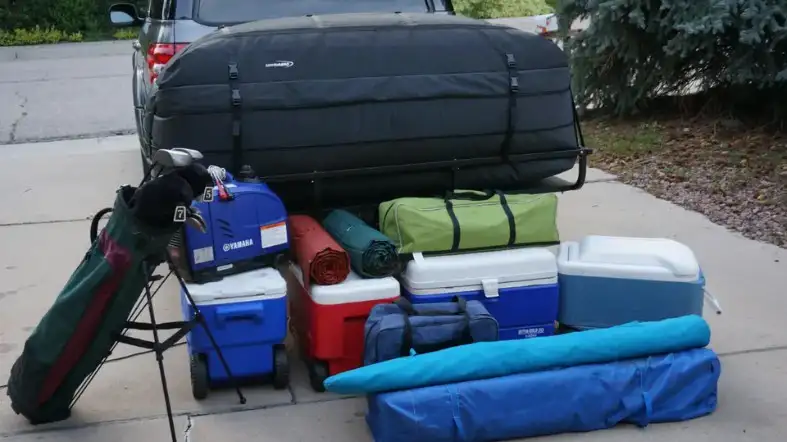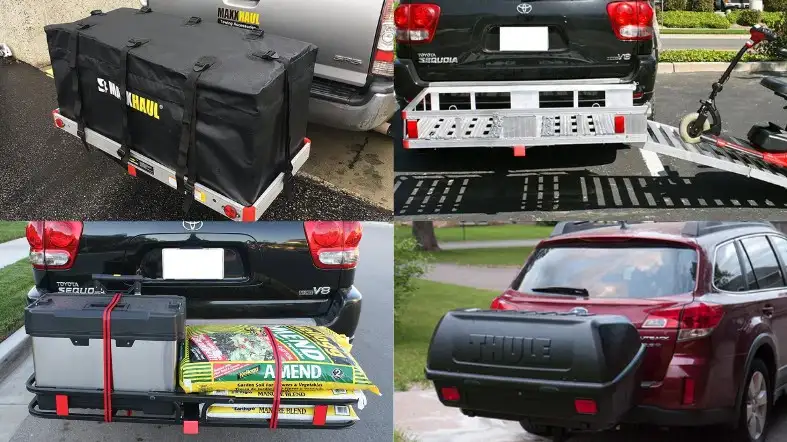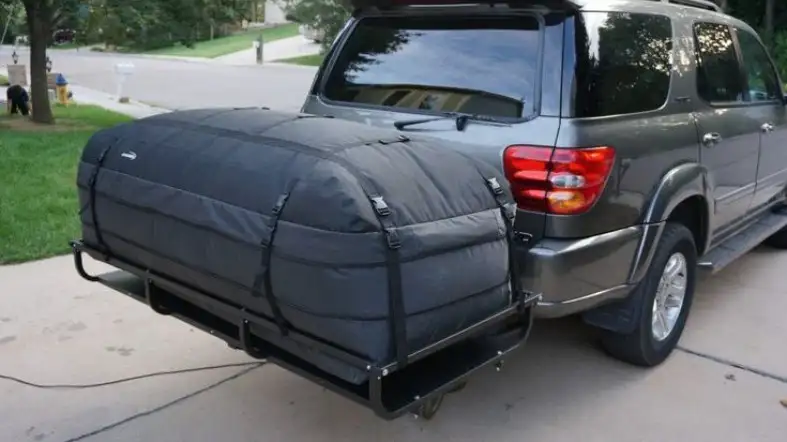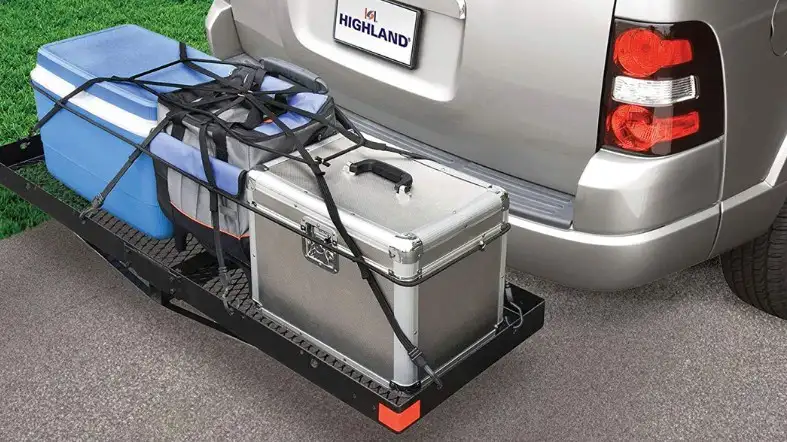If you’re planning a road trip or just need to haul extra gear, a hitch cargo carrier can be a lifesaver.
This handy accessory attaches to the back of your vehicle and provides extra storage space for all your gear.
Whether you’re packing camping equipment or sporting goods, or just need some extra room for luggage, a hitch cargo carrier can be a convenient and easy way to transport your items.
In this blog, we’ll go over the steps on how to properly pack and secure your items in a hitch cargo carrier, ensuring that your belongings are safe and secure during your travels.
So let’s get started!
How to pack a hitch cargo carrier?
Before parking your hitch cargo carrier, make sure to select a level and sturdy surface for stability and follow the steps.

Step 1: Measure and weigh your items
Before packing your hitch cargo carrier, it is important to measure and weigh your items to ensure that they fit within the carrier’s size and weight limits.
It is also a good idea to check the maximum weight limit of your vehicle’s hitch to ensure that it can safely support the weight of the carrier and its contents.
Step 2: Gather the necessary equipment
In addition to the hitch cargo carrier, you will need a few other items to safely and securely pack your items.
This may include bungee cords, rope, ratchet straps, and a tarp.
Step 3: Secure the cargo carrier to your vehicle
Before loading any items onto the cargo carrier, you should first secure them in your vehicle.
This typically involves attaching the carrier to the hitch using a hitch pin and clip and adjusting the carrier to ensure that it is level and properly aligned with the vehicle.
Step 4: Load Your Items Into The Carrier
Once the cargo carrier is securely attached to your vehicle, you can begin loading your items onto it.
It is important to evenly distribute the weight of the items across the carrier to ensure that it is balanced and stable.
You should also use bungee cords, rope, or ratchet straps to secure the items in place, particularly if they are prone to shifting or movement during transport.
Step 5: Cover your items with a tarp
If you are transporting items that are prone to damage from the elements (such as furniture or electronics), it is a good idea to cover them with a tarp.
This will protect them from rain, wind, and other weather conditions during transport.
Step 6: Check your items and the carrier before driving
Before hitting the road, take a few minutes to double-check your items and the cargo carrier to ensure that everything is properly packed and secured.
This includes checking the hitch pin and clip to make sure that the carrier is securely attached to the vehicle and re-securing any items that may have become loose during loading.
9 Tips To Packing a Hitch Cargo Carrier Efficiently
- Start by loading the heaviest items at the bottom. This will help to keep the load stable and prevent it from tipping over.
- Pack the items tightly together. This will help to prevent the load from shifting during travel.
- Secure the load with tie-downs. This is essential to prevent the load from coming loose and causing a hazard.
- Keep the load as low as possible. This will help to improve fuel economy and reduce wind resistance.
- Do not overload the cargo carrier. Overloading can cause the carrier to sag or even break, which could be dangerous.
- Check the weight capacity of the cargo carrier and your vehicle. Make sure that the weight of the load does not exceed the maximum weight capacity of either.
- If you are transporting long or sharp objects, secure them so that they do not protrude from the sides of the cargo carrier. This could cause damage to your vehicle or other vehicles on the road.
- If you are transporting fragile items, pack them in a way that will protect them from damage. This could involve using bubble wrap, packing peanuts, or other protective materials.
- Be sure to follow the manufacturer’s instructions for loading and securing your cargo carrier. This will help to ensure that your load is safe and secure during travel.
Here are some additional tips:
- If you are packing a cargo carrier with bulky items, such as bicycles or kayaks, you may need to remove the wheels or other removable parts. This will help reduce the load’s overall height and make it easier to load and secure.
- If you are packing a cargo carrier with a variety of items, try to group like items together. This will help keep the load organized and make it easier to find what you need on the road.
- If you are packing a cargo carrier for a long trip, be sure to pack some essential items, such as tools, a first-aid kit, and flares. These items could come in handy in case of an emergency.
Types of Hitch Cargo Carriers

There are several types of hitch cargo carriers available, each with its own unique features and benefits:
Hard-Sided Hitch Cargo Carriers
Hard-sided hitch cargo carriers are made of sturdy materials such as aluminum or steel and offer a secure and durable option for transporting large or heavy items.
These carriers often have lock mechanisms to keep items safe and are ideal for items that need to be protected from the elements.
However, they can be more expensive and heavier to install, and may not be as convenient for loading and unloading smaller items.
Soft-Sided Hitch Cargo Carriers
Soft-sided hitch cargo carriers are made of a lightweight, flexible material such as canvas or nylon.
They offer more flexibility in terms of the size and shape of items being transported, as the sides can be cinched down or left open for larger items.
They are also often easier to install and remove and can be more affordable than hard-sided carriers.
However, they may not offer as much protection for items, and may not be as durable in extreme weather conditions.
Enclosed Hitch Cargo Carriers
Enclosed hitch cargo carriers offer the most protection for items being transported, as they are fully enclosed with a roof and sides.
They are ideal for items that need to be protected from the elements, such as electronics or sensitive equipment.
However, they can be more expensive and heavier to install, and may not be as convenient for loading and unloading smaller items.
Ultimately, the best type of hitch cargo carrier will depend on the specific needs and preferences of the user.
Factors to consider may include the size and weight of items being transported, the type of vehicle being used, and the budget.
It is important to carefully consider the pros and cons of each type of carrier to choose the one that will best meet the needs of the user.
Tips For Selecting The Right Size And Capacity For Your Needs

When it comes to selecting the right size and capacity for your needs, it can be overwhelming with all the options available on the market.
Whether you are looking for a new refrigerator, washing machine, or storage container, it is important to consider your needs and preferences before making a purchase.
Here are a few tips to help you choose the right size and capacity for your needs:
1. Consider the size of your space:
Before selecting a size, measure the space where you plan to store or use the item.
This will help ensure that you choose a size that fits comfortably and doesn’t take up too much room.
2. Think about your usage:
Consider how often you plan to use the item and the number of items you need to store.
For example, if you only need to store a few items occasionally, a smaller size may be sufficient.
However, if you need to store a large number of items regularly, a larger size may be necessary.
3. Consider your budget:
Keep in mind the cost of the item when selecting the size and capacity.
Larger sizes and higher capacities may come at a higher price, so consider if it is worth the investment.
4. Check the dimensions:
Make sure to check the dimensions of the item to ensure it will fit through doorways, around corners, and in the space where you plan to store or use it.
5. Read reviews:
Look for reviews from other users to get an idea of the capacity and size of the item.
This can help you determine if it is sufficient for your needs.
6. Consider additional features:
Some items may come with additional features such as wheels or handles that can make them easier to move and store.
Consider if these features are important to you and if they are worth the additional cost.
Importance Of Properly Packing And Securing Your Items

Protecting Your Belongings
Properly packing and securing items during transit is crucial to prevent damage or loss. When you take care in packing your items, you shield them from external harm, like scratches, dents, or water damage.
Delicate or valuable items, such as electronics, art, or antiques, require special attention to ensure they reach their destination unscathed.
Using materials like bubble wrap, foam, or sturdy boxes offers a protective cocoon against rough handling, temperature fluctuations, or humidity changes.
Safeguarding Against Loss and Theft
Secure packing is equally vital to thwart loss or theft during transit. For sentimental items or things that are challenging to replace, you want to be extra cautious.
Employ tamper-evident packaging or locks and seals on boxes to keep your belongings secure throughout the journey.
Knowing your items are safe and sound will bring you peace of mind during the transportation process.
Preventing Accidents and Injuries
The proper packing and securing of items can also have a direct impact on preventing accidents or injuries during transit.
When items aren’t adequately secured in a vehicle or on a pallet, they have the potential to shift or fall during the journey. Such unexpected movements can lead to damages or injuries to people or property.
To minimize risks, use restraints or straps to secure items firmly in place. This proactive measure ensures a safer and smoother transportation experience.
The Bottom Line
In summary, properly packing and securing items during transit is essential for multiple reasons. By taking the time and care to pack your belongings properly, you shield them from damage, loss, or theft.
Additionally, secure packing prevents accidents and injuries, keeping both your items and others around you safe.
Investing in proper packing materials and taking a meticulous approach will ensure that your items arrive at their destination in the same pristine condition they were in when you started your journey.
FAQs on How To Pack A Hitch Cargo Carrier
What Is A Hitch Cargo Carrier?
A hitch cargo carrier is a device that attaches to the back of a vehicle and allows you to transport extra gear or luggage.
It can be mounted on a hitch receiver and is often used when you don’t have enough room inside your vehicle.
What Should I Consider When Choosing A Hitch Cargo Carrier?
You should consider the size of your vehicle’s hitch receiver, the weight and size of the items you want to transport, and the materials of the carrier itself.
You should also consider any additional features such as a built-in locking system or waterproof cover.
How Do I Attach A Hitch Cargo Carrier To My Vehicle?
First, make sure that the hitch receiver on your vehicle is compatible with the cargo carrier.
Then, align the hitch cargo carrier with the hitch receiver and slide it into place.
Secure it with the appropriate bolts or pins, and make sure it is tightened properly.
Can I Use A Hitch Cargo Carrier On Any Vehicle?
Not necessarily. Some vehicles may not have a hitch receiver or may have a receiver that is not compatible with certain types of cargo carriers.
It’s important to check the specifications of your vehicle and the hitch cargo carrier to ensure that they are compatible.
How Do I Pack My Hitch Cargo Carrier Safely And Efficiently?
First, make sure all of your items are properly secured and won’t shift during transport.
Use tie-downs, bungee cords, or other restraints to keep everything in place.
You should also distribute the weight evenly across the carrier to avoid overloading one side.
Finally, be sure to follow any weight or size restrictions that may be imposed by the manufacturer.
Conclusion
In conclusion, packing a hitch cargo carrier can seem intimidating at first, but with a little planning and organization, it can be a breeze.
By following these tips and using the proper equipment, you can ensure that your belongings are safe and secure during your road trip.
Always remember to distribute the weight evenly and double-check all straps and tie-downs before hitting the road.
With a little preparation, your hitch cargo carrier can be a great asset on your next adventure.
